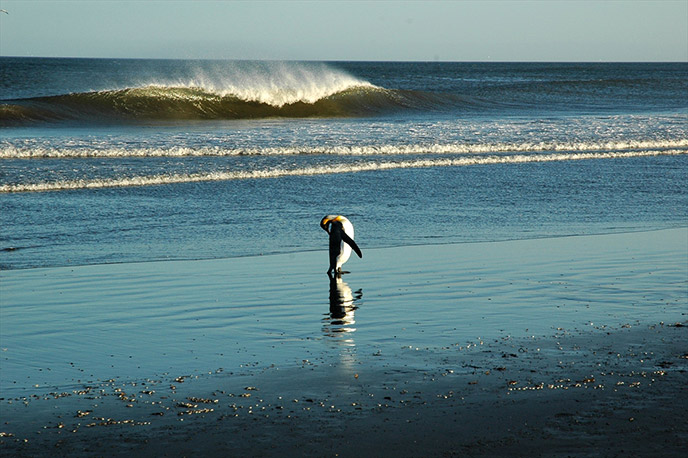National Institute of Polar Research
United Nations sea treaty should help protect penguins, researchers say
Posted on December 10, 2021
Researchers are calling for the United Nations to implement an ambitious treaty that would help to protect marine biodiversity, including penguins who make spectacular, large-scale migrations at sea, crossing national borders, across their lifetimes. The international team reviewed 131 papers on penguin movements at sea and found that 13 of 18 species travel in international waters and may benefit from increased protections.

A king penguin (Aptenodytes patagonicus) preens on the Kerguelen Islands in the subantarctic Indian Ocean. Dubbed an “ocean wanderer,” this type of penguin demonstrates the extensive, large-scale sea movements of many animals across national boundaries and who may benefit from increased protections implemented by a United Nations sea treaty. Credit: Jean-Baptiste Thiebot (NIPR)
Penguins may not require passports to travel, but they do need protection, according to an internatonal research team who analyzed 131 scientific papers on penguin movement at sea. The work comes as the United Nations continues to negotiate a treaty regarding the sustainable use of areas beyond national jurisdiction, the high seas over which no coastal state can claim ownership.
The researchers published their conclusions — and a call for specific protections to help conserve and restore marine biodiversity — in the September issue of Marine Policy.
“In the marine environment, coastal states typically retain management of waters up to 200 nautical miles from their shorelines, but beyond that, the high seas, which represent 64% of the ocean’s surface and 95% of its volume, are considered global commons,” said first author Jean-Baptiste Thiebot, a project researcher at the National Institute of Polar Research in Japan. “Penguins are, largely, ocean wanderers: they venture well offshore during some — or all — of their life stages. Hence, while the public may not think of penguins as traveler animals, we show that penguins are indeed extremely mobile. This mobility also widens the range of threats that they may face at sea, and, in particular, human activities that are intensifying in the high seas.”
Among the most threatened seabird groups, penguins face the most danger at sea from pollution, fishing and climate change. However, Thiebot said, the severity of these threats is largely unknown in areas beyond national jurisdiction. To help elucidate the effects on penguins, Thiebot and paper co-author Magali Dreyfus, research manager at Université de Lille in France, reviewed existing scientific literature on 18 penguin species and their movements.
“Transboundary movements, notably to areas beyond national jurisdiction, are remarkably prevalent among penguin species — there are at least 120 cases of penguins, representing 13 species, using such areas,” Thiebot said. “We highlight that in 16 of the 18 species examined, the birds may undertake spectacular migrations, seasonally or through life-cycle stages.”
According to Thiebot, such movement may depend on the particular life-cycle stage or seasonal need of a species, indicating a need for a more flexible, mobile approach to protecting areas in the high seas.
“We show that the use of areas beyond national jurisdiction by penguin species varies throughout the year, a dynamic pattern supporting the pertinence of developing innovative protection tools, such as mobile marine protected areas,” Thiebot said, referencing a relatively recent management approach facilitated by the use of satellites and other remote monitoring. The protections for a certain area move with the species or features being protected, rather than remaining static as they would on land.
This work follows a letter in Science calling for legal protection for high seas biodiversity, co-authored by 20 researchers from across the globe, including Thiebot.
“The current paper is part of a large effort by scientists worldwide to explain the stakes of protecting this biodiversity in the high seas,” Thiebot said. “In the present paper, we examined to what extent penguins are known to use the high seas, and to what extent the conservation of penguins may depend on these legally binding developments.”
The answer for both, they found, is significant, but more work is needed, according to Thiebot.
“Building on our first-step general approach, further analyses will be required to identify exactly which sites in areas beyond national jurisdiction are a priority for conservation,” Thiebot said. “In the meantime, the ongoing expansion of tracking studies will be key to provide a more complete perspective on the use of areas beyond national jurisdiction by penguins across species, sites and seasons.”
Original article:
Journal: Marine Policy
Title: Protecting marine biodiversity beyond national jurisdiction: A penguins’ perspective
Authors:
Jean-Baptiste Thiebot (National Institute of Polar Research)
Magali Dreyfus (CNRS, CERAPS-Lille University)
DOI: 10.1016/j.marpol.2021.104640
URL: https://www.sciencedirect.com/science/article/abs/pii/S0308597X21002517
Published Online: 23 June 2021








